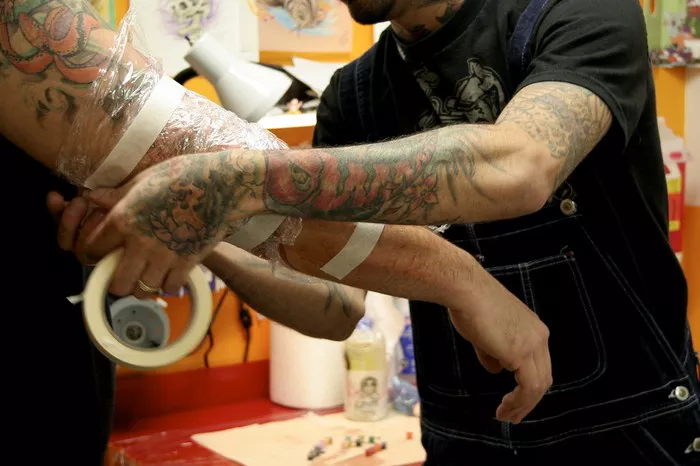Cover-up tattoos serve a dual purpose: they can transform an unwanted or regrettable design into a piece of art while also providing a sense of renewal and empowerment for the wearer. This guide explores the intricate process of designing an effective cover-up tattoo, offering insights into techniques, styles, and considerations to ensure your new design not only conceals the old one but also reflects your personality and story.
Understanding Cover-Up Tattoos
What is a Cover-Up Tattoo?
A cover-up tattoo is a new tattoo applied over an existing one to conceal it. The goal is to create a design that effectively masks the old ink while providing a fresh, appealing look.
Why People Choose Cover-Ups
Individuals may choose cover-ups for various reasons, including:
Regret: Many people regret impulsive tattoos from their younger years.
Change in Aesthetic: Personal tastes can evolve, making previous designs feel outdated.
Life Changes: Significant life events may prompt a desire for a tattoo that better represents current beliefs or experiences.
Factors to Consider When Designing a Cover-Up Tattoo
Assessing the Existing Tattoo
Size and Color: Evaluate the size, color, and detail of the existing tattoo. Dark colors require more coverage than lighter shades.
Design Complexity: Simple tattoos may be easier to cover than intricate designs.
Choosing the Right Artist
Research: Look for artists specializing in cover-up tattoos. Review their portfolios to gauge their skill in transforming old designs.
Consultation: Discuss your ideas and expectations with potential artists. A good artist will provide guidance and suggestions based on their experience.
Understanding Ink and Skin
Ink Saturation: Darker inks may require more complex designs to ensure effective coverage.
Skin Type: Skin texture and tone can affect how colors appear. Your artist should consider these factors when designing your cover-up.
See also: The Gender Ink Divide: Who Gets the Most Tattoos?
Design Techniques for Effective Cover-Ups
Layering and Overlapping
Creative Overlays: Use elements that can overlap the old design without drawing attention to it. This technique can add depth and intrigue to the new tattoo.
Incorporating Shadows and Highlights
Shading Techniques: Incorporate shading to blend the old tattoo into the new design. Skillful use of shadows can create a more cohesive look.
Choosing Bold Colors
Vibrancy: Bright colors can effectively mask dark inks. Consider incorporating vibrant elements that draw attention away from the covered tattoo.
Utilizing Larger Designs
Full-Sleeve or Back Pieces: Sometimes, a larger design is necessary to fully cover an old tattoo. These pieces can tell a complete story or convey a theme.
Popular Themes for Cover-Up Tattoos
Floral Designs
Symbolism: Flowers can symbolize growth and transformation, making them a popular choice for cover-ups.
Versatility: They can vary in size and complexity, fitting many existing designs.
Animals and Mythical Creatures
Powerful Symbolism: Animals often represent specific traits or qualities, allowing for personal expression.
Creative Freedom: Mythical creatures provide an opportunity to create a fantastical design that draws the eye.
Abstract and Geometric Patterns
Distraction Through Complexity: Abstract art and geometric shapes can effectively mask underlying tattoos by drawing focus to their complexity.
Modern Appeal: These designs can offer a contemporary look, appealing to those who prefer minimalist styles.
Portraits and Realism
Personal Significance: Portraits of loved ones or admired figures can create a deep personal connection.
Artistic Challenge: Realistic designs can be challenging but rewarding for both the artist and the wearer.
Planning Your Cover-Up Tattoo
Collaborating with Your Artist
Open Dialogue: Share your vision and any reference images with your artist. They can help refine your ideas into a cohesive design.
Sketch Review: Request a sketch of the proposed design to ensure it aligns with your expectations before getting inked.
Timing and Sessions
Multiple Sessions: Depending on the complexity, a cover-up may require multiple sessions. Be prepared for this to achieve the best results.
Aftercare Considerations
Healing Process: Proper aftercare is essential for the healing of a cover-up tattoo. Follow your artist’s instructions to ensure the design heals well and retains its vibrancy.
Common Challenges and Solutions
Dark Ink Show-Through
Solution: Opt for darker, bolder colors or detailed designs to prevent any show-through.
Uneven Skin Texture
Solution: Discuss skin texture issues with your artist. They may recommend techniques that work best for your skin type.
Emotional Attachment to Old Tattoo
Solution: Acknowledge any emotional connections you have with the original tattoo. A skilled artist can help you incorporate elements of the old design into the new one, creating a bridge between the two.
Success Stories
Transformative Examples
Share inspiring stories of individuals who successfully transformed their tattoos through cover-ups, highlighting the emotional and artistic journey involved.
Conclusion
Designing a cover-up tattoo is an art that requires thoughtful consideration, creativity, and collaboration with a skilled artist. By understanding the factors involved, choosing the right design, and preparing for the journey, you can transform a regretful tattoo into a stunning piece of art that you’ll cherish for years to come.
This guide provides a detailed framework for understanding and designing cover-up tattoos, ensuring that the process is as fulfilling and empowering as the end result.
You Might Be Interested In
Did Vikings Have Tattoos? Myth and Mystery of Viking Body Art

